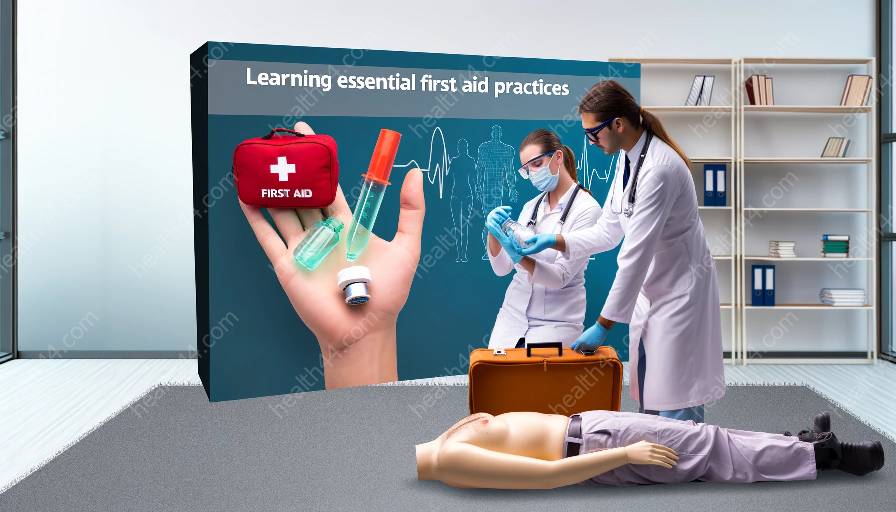When it comes to providing first aid for infants and children, it's crucial to have the right knowledge and skills to handle medical emergencies effectively. From CPR to treating burns and cuts, being prepared to administer first aid can make a significant difference in saving lives and preventing further complications.
Essential First Aid Techniques for Infants and Children
Understanding the differences in administering first aid to infants and children compared to adults is essential. Here are some essential first aid techniques for infants and children:
- CPR: Cardiopulmonary resuscitation (CPR) is a life-saving technique that can significantly increase the chances of survival for infants and children experiencing cardiac arrest or respiratory failure. Knowing how to perform CPR on infants and children is crucial for caregivers and parents.
- Choking: Choking is a common emergency in infants and young children. Learn how to recognize and respond to choking incidents promptly to prevent asphyxiation and potential brain damage.
- Burns: Children are prone to burns from hot objects, liquids, or chemicals. Knowing how to provide immediate first aid for burns can minimize the damage and reduce the risk of further complications.
- Fractures and Sprains: Children are active and often engage in physical activities that may result in fractures or sprains. Knowing how to stabilize and provide initial first aid for fractures and sprains is crucial.
- Allergic Reactions: Recognizing the symptoms of allergic reactions and knowing how to administer first aid and use an epinephrine injector (EpiPen) can be life-saving for children with severe allergies or anaphylaxis.
- Head Injuries: Children are susceptible to head injuries from falls and accidents. Understanding how to recognize and respond to head injuries is essential to prevent further complications.
Health Education and Medical Training for Caregivers
Health education and medical training play a vital role in equipping caregivers, parents, and childcare providers with the knowledge and skills to respond effectively to medical emergencies involving infants and children. Here are ways to enhance health education and medical training for caregivers:
- CPR and First Aid Certification: Enroll in a CPR and first aid certification course specifically tailored to infants and children. These courses provide hands-on training and simulations to ensure caregivers are proficient in administering first aid when it matters most.
- Child Safety and Injury Prevention: Educate caregivers about child safety measures and injury prevention strategies. This includes creating a safe environment, childproofing homes, and teaching caregivers about potential hazards and risks to avoid accidents.
- Awareness of Age-Appropriate First Aid: Understand the differences in providing first aid to infants, toddlers, and older children. Age-appropriate first aid ensures that caregivers are equipped to respond effectively to the unique needs of each age group.
- Medical Emergency Action Plan: Develop and communicate a clear medical emergency action plan for infants and children in childcare settings. This includes identifying emergency contacts, medical history, and procedures to follow in case of a medical emergency.
- Pool Safety: Knowing how to perform CPR on infants and children in the event of a near-drowning incident can be life-saving. Understanding pool safety and immediate response measures is essential for preventing fatalities.
- Choking Incidents: Promptly recognizing and responding to choking incidents in infants and children can prevent airway obstruction and associated risks. Caregivers should be prepared to administer first aid for choking to ensure the child's safety.
- Allergy Management: Understanding how to recognize and manage severe allergic reactions, including administering epinephrine, can prevent life-threatening outcomes in children with known allergies.
- Sports-Related Injuries: Providing immediate first aid for fractures, sprains, and head injuries in sports-related incidents is crucial for preventing further damage and promoting timely medical intervention.
Real-World Application of First Aid Knowledge
Applying first aid knowledge in real-world scenarios is crucial for caregivers, parents, and childcare providers. Here are some real-world examples of how first aid for infants and children can make a difference:
Conclusion
First aid for infants and children requires a combination of knowledge, skills, and preparedness. By understanding essential first aid techniques, enhancing health education and medical training, and applying first aid knowledge in real-life scenarios, caregivers, parents, and childcare providers can be better equipped to respond effectively to medical emergencies involving infants and children.



